The Ultimate Guide To Swimming Pool Maintenance
The swimming pool! The stand-out feature of your villa, and focal point to hour upon hour of family fun and relaxation. But just like house cleaning, without the proper swimming pool maintenance, your pool will quickly become filthy, smelly and just plain unappealing.
Pool cleaning is not something that really appeals when all you want to do is be swimming and splashing around. However, with the correct strategies you can be back enjoying the water in no time at all.
This post explains the basic necessities of domestic swimming pool maintenance and what needs to be done to ensure you keep your pool in top condition and prolong the life of your pool equipment.
The following topics are all important for regular swimming pool maintenance; don’t skip any of these tasks!
- Regular cleaning of: Pumps, Filters, Skimmers
- Regular cleaning of Automated Robots, Vacuums
- Ensuring the correct balance of chemicals is maintained
- Swimming pool cover maintenance
- Check for leaks in vinyl liners
Regular Pool Cleaning
So how much is swimming pool maintenance? In Lanzarote the cost varies between €20-25 per clean depending on the level of service. However, if you are looking to do some of the general tasks yourself here is some basic knowledge that will help you. It is common sense that the water in your pool needs cleaning regularly. However, what is sometimes overlooked is that scrubbing the walls of your pool are equally important. Ensuring the filters and pumps are free from debris is another task that will ensure uninterrupted use of your pool.
Skim the Surface
Skim the surface of your pool every day. Leaves and insects build up constantly; removing this debris will keep the water fresh and prevent the rubbish from sinking to the floor of your pool. Using a telescopic pole and net, simply skim across the surface of the pool and empty the contents frequently.
Brushing the walls of your pool will remove chemical residue and dirt which could potentially cause the growth of algae which leads to your pool turning green. Scrubbing the sides of the pool will force the dirt into the pool making it easier to vacuum up later. A cheap supermarket degreaser is sufficient for this task.
Vacuuming the Pool
If you are going to attempt to vacuum your own pool, the first thing you must do is eliminate air from your hose. Lower your vacuum head to the bottom of the pool and then submerge your hose until it fills with water. You will know this is complete when water emerges from the other end. Attach the hose end to your vacuum or skimmer port and you are now ready to begin “hoovering”. When you have finished, turn the filtration system back on.
If you are going to clean your pool on a regular basis you must not overlook the cleaning of your filters and pump too. A dirty filter will lead to poor circulation in the pool causing the water to become more dirty than normal. The most common filter system on Lanzarote is the Sand Filter. To clean this you must turn on the pump for around 15 seconds to allow clean water to flow around the filter. Complete the process by backwashing the filter before returning the setting to normal.
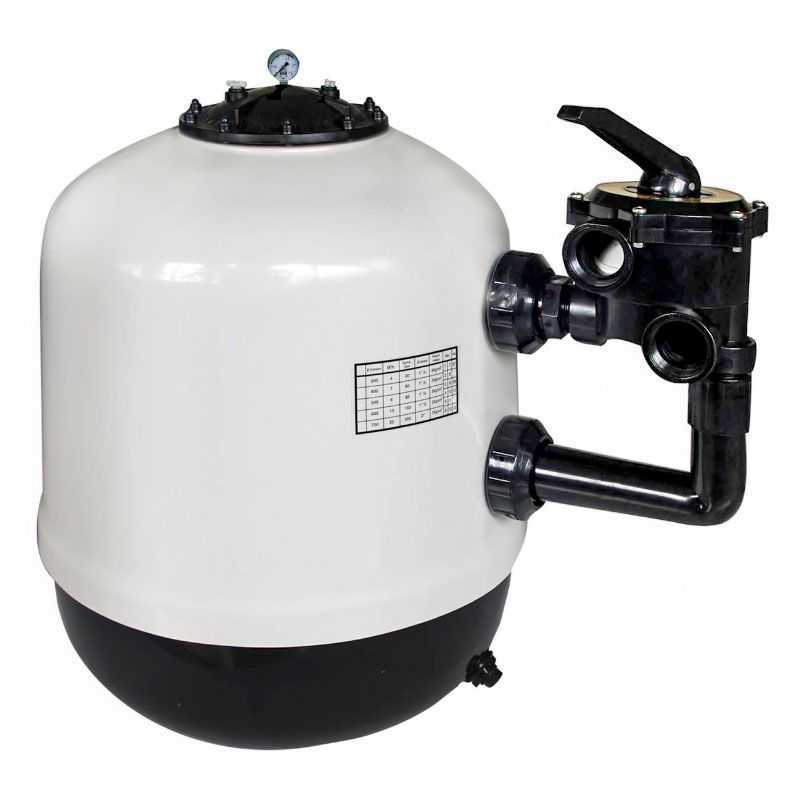

Balancing Chemicals
The reason we have to use chemicals in our water is that at any specific time you have no way of knowing what exactly is in your water. Contaminants, if left, will build up over a period of time and cause you big problems in the future. Using a water testing kit on a regular basis makes good sense. Ensuring the balance of the water is ideal, is a task that needs to be done at least once a week. Try to get a sample of water from the centre of the pool using a clean bucket or jar. For a basic job, the main 2 tests you should perform are to check the pH balance and the chlorine levels. The pH balance should read between 7 and 7.6. If the reading is higher than 8 you are liable to develop skin rashes whereas if the level is below 7, the water could sting your eyes. You should perform the pH balance first as chlorine is only really effective if your pH balance is correct. Once the pH balance is correct you can test the levels of chlorine in the water using your testing kit. You should aim to have a chlorine level of 3 ppm ( parts per million ). All the above chemicals that you require can be found at M.V.P Playa Blanca.
The testing kits can be bought very cheaply at Ferreteria Playa Blanca.
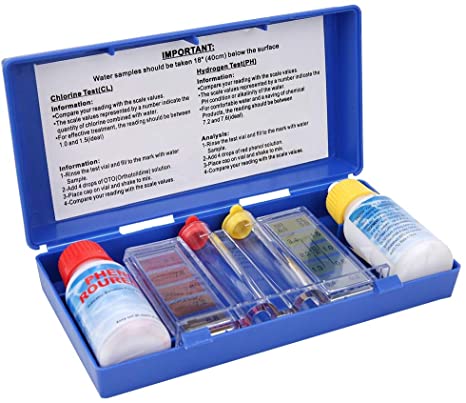
The Ultimate Guide To Swimming Pool Maintenance
The swimming pool! The stand-out feature of your villa, and focal point to hour upon hour of family fun and relaxation. But just like house cleaning, without the proper swimming pool maintenance, your pool will quickly become filthy, smelly and just plain unappealing.
Pool cleaning is not something that really appeals when all you want to do is be swimming and splashing around. However, with the correct strategies you can be back enjoying the water in no time at all.
This post explains the basic necessities of domestic swimming pool maintenance and what needs to be done to ensure you keep your pool in top condition and prolong the life of your pool equipment.
The following topics are all important for regular swimming pool maintenance; don’t skip any of these tasks!
- Regular cleaning of: Pumps, Filters, Skimmers
- Regular cleaning of Automated Robots, Vacuums
- Ensuring the correct balance of chemicals is maintained
- Swimming pool cover maintenance
- Check for leaks in vinyl liners
Regular Pool Cleaning
So how much is swimming pool maintenance? In Lanzarote the cost varies between €20-25 per clean depending on the level of service. However, if you are looking to do some of the general tasks yourself here is some basic knowledge that will help you. It is common sense that the water in your pool needs cleaning regularly. However, what is sometimes overlooked is that scrubbing the walls of your pool are equally important. Ensuring the filters and pumps are free from debris is another task that will ensure uninterrupted use of your pool.
Skim the Surface
Skim the surface of your pool every day. Leaves and insects build up constantly; removing this debris will keep the water fresh and prevent the rubbish from sinking to the floor of your pool. Using a telescopic pole and net, simply skim across the surface of the pool and empty the contents frequently.
Brushing the walls of your pool will remove chemical residue and dirt which could potentially cause the growth of algae which leads to your pool turning green. Scrubbing the sides of the pool will force the dirt into the pool making it easier to vacuum up later. A cheap supermarket degreaser is sufficient for this task.
Vacuuming the Pool
If you are going to attempt to vacuum your own pool, the first thing you must do is eliminate air from your hose. Lower your vacuum head to the bottom of the pool and then submerge your hose until it fills with water. You will know this is complete when water emerges from the other end. Attach the hose end to your vacuum or skimmer port and you are now ready to begin “hoovering”. When you have finished, turn the filtration system back on.
If you are going to clean your pool on a regular basis you must not overlook the cleaning of your filters and pump too. A dirty filter will lead to poor circulation in the pool causing the water to become more dirty than normal. The most common filter system on Lanzarote is the Sand Filter. To clean this you must turn on the pump for around 15 seconds to allow clean water to flow around the filter. Complete the process by backwashing the filter before returning the setting to normal.


Balancing Chemicals
The reason we have to use chemicals in our water is that at any specific time you have no way of knowing what exactly is in your water. Contaminants, if left, will build up over a period of time and cause you big problems in the future. Using a water testing kit on a regular basis makes good sense. Ensuring the balance of the water is ideal, is a task that needs to be done at least once a week. Try to get a sample of water from the centre of the pool using a clean bucket or jar. For a basic job, the main 2 tests you should perform are to check the pH balance and the chlorine levels. The pH balance should read between 7 and 7.6. If the reading is higher than 8 you are liable to develop skin rashes whereas if the level is below 7, the water could sting your eyes. You should perform the pH balance first as chlorine is only really effective if your pH balance is correct. Once the pH balance is correct you can test the levels of chlorine in the water using your testing kit. You should aim to have a chlorine level of 3 ppm ( parts per million ). All the above chemicals that you require can be found at M.V.P Playa Blanca.
The testing kits can be bought very cheaply at Ferreteria Playa Blanca.

Swimming Pool Cover Maintenance
Why do I need a swimming pool cover?
Pool covers have numerous benefits and as such should be given the same amount of attention that you would give to cleaning your pool. Firstly, they will help to maintain the cleanliness of your pool by collecting debris such as leaves, sand and insects. Secondly, they help maintain the level of the water in your pool by preventing evaporation. Thirdly, they will retain the heat in your pool much more efficiently by acting as a blanket. You can expect a pool with a cover to be around 5 degrees warmer than one without. Fourthly, when debris falls into your pool the chemicals will act upon this debris breaking it down and consequently using up the chlorine much more quickly. Fifthly, the cover helps to protect the filter becoming blocked and finally a cover gives a better layer of protection against accidents with small children and pets falling into the pool.
There are mainly 3 types of pool cover available:
Solar Cover
Known as “bubble covers”, these are the most popular covers in Lanzarote offering the ability to prevent light debris from entering the pool, retaining your pools’ heat, and are relatively inexpensive.
Slatted Cover
More expensive than the solar cover, these offer a bespoke design whereby multiple slats cover the width of your pool offering a higher level of protection and providing a more robust safety element.
Safety Cover
This is the ultimate pool cover with the highest level of protection. The cover is attached to tracks running alongside your pool and is operated by a hydraulic pump. By completely covering the pool, the cover can accommodate the weight of adults and children and is the most efficient at heat retention. Expect to pay around €12,000 for this luxury cover.
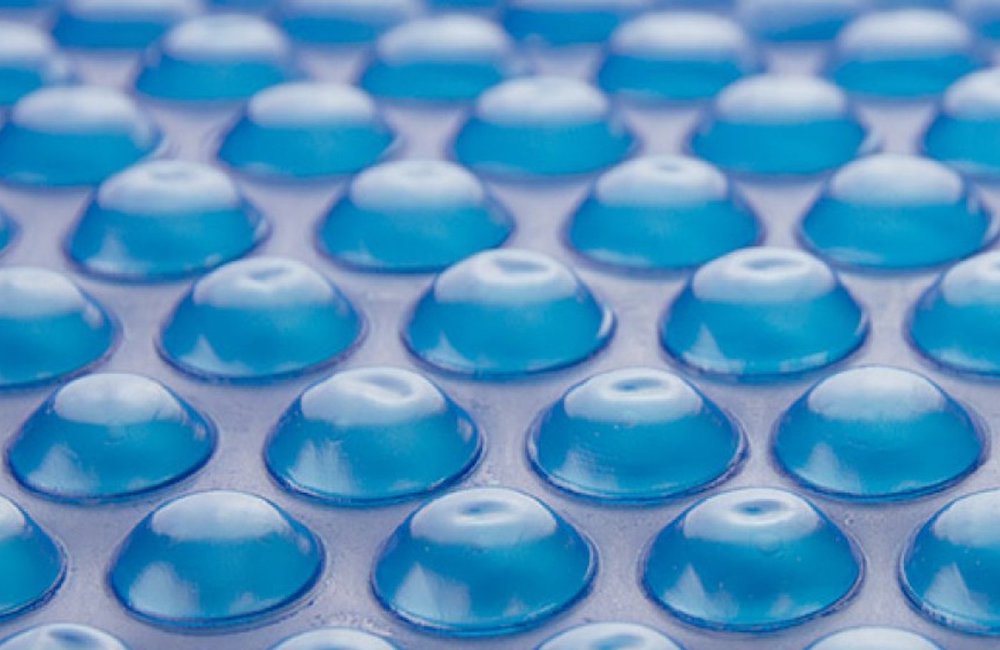
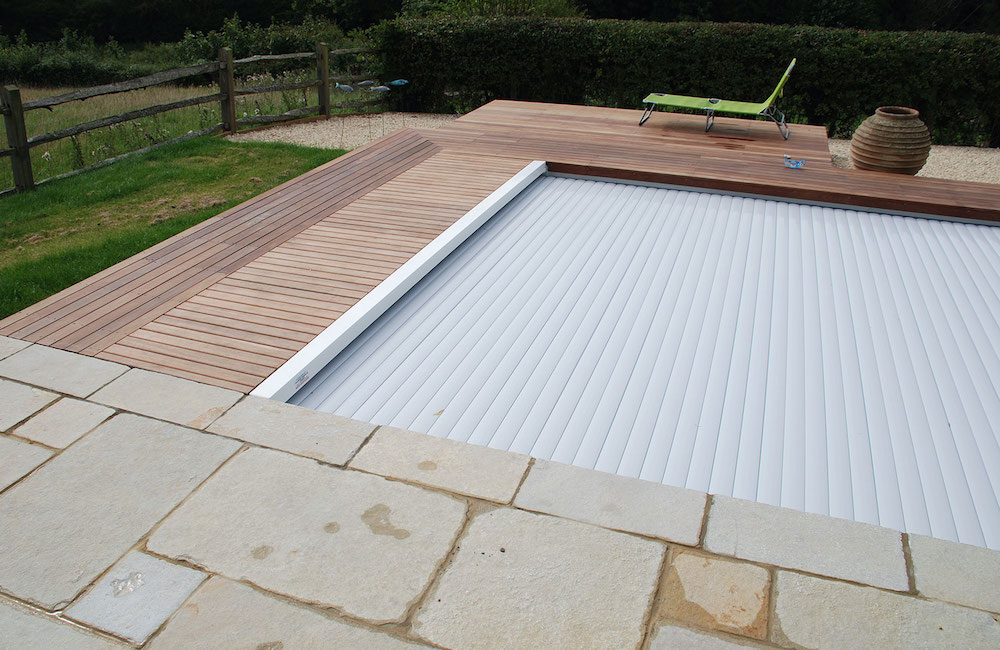
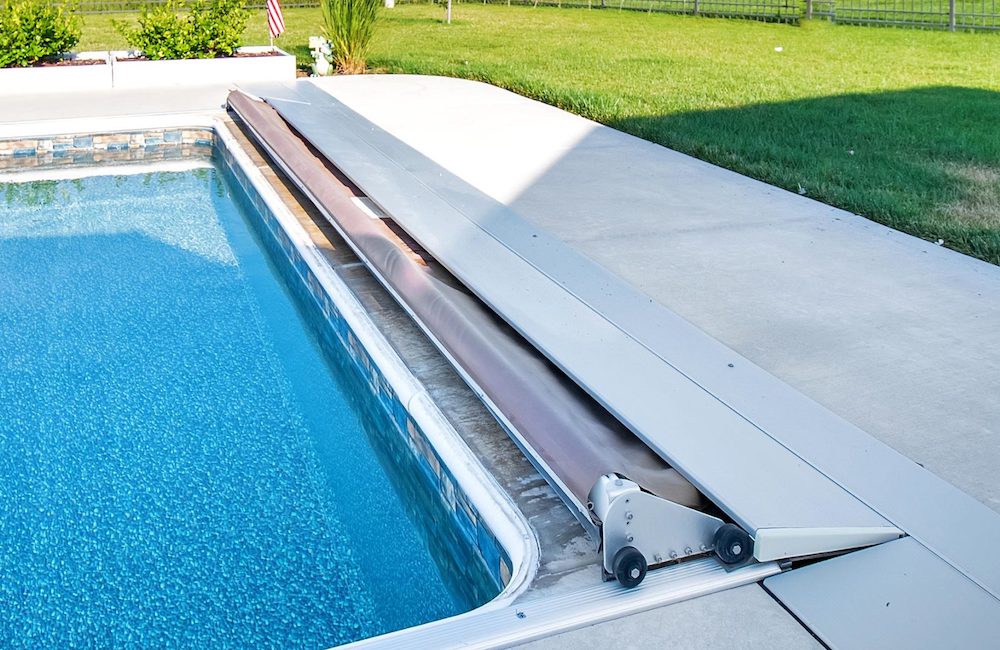
Swimming Pool Cover Maintenance
Why do I need a swimming pool cover?
Pool covers have numerous benefits and as such should be given the same amount of attention that you would give to cleaning your pool. Firstly, they will help to maintain the cleanliness of your pool by collecting debris such as leaves, sand and insects. Secondly, they help maintain the level of the water in your pool by preventing evaporation. Thirdly, they will retain the heat in your pool much more efficiently by acting as a blanket. You can expect a pool with a cover to be around 5 degrees warmer than one without. Fourthly, when debris falls into your pool the chemicals will act upon this debris breaking it down and consequently using up the chlorine much more quickly. Fifthly, the cover helps to protect the filter becoming blocked and finally a cover gives a better layer of protection against accidents with small children and pets falling into the pool.
There are mainly 3 types of pool cover available:
Solar Cover
Known as “bubble covers”, these are the most popular covers in Lanzarote offering the ability to prevent light debris from entering the pool, retaining your pools’ heat, and are relatively inexpensive.
Slatted Cover
More expensive than the solar cover, these offer a bespoke design whereby multiple slats cover the width of your pool offering a higher level of protection and providing a more robust safety element.
Safety Cover
This is the ultimate pool cover with the highest level of protection. The cover is attached to tracks running alongside your pool and is operated by a hydraulic pump. By completely covering the pool, the cover can accommodate the weight of adults and children and is the most efficient at heat retention. Expect to pay around €12,000 for this luxury cover.



Checking for Leaks
There are 2 quick and easy tests you can do to see if you have a leak in your pool liner.
Dye Test
If you detect what you think maybe a crack or tear in your pool liner, you should purchase a dye testing kit from your local supplier. Tears and cracks are generally found in high traffic areas of the pool such as the steps. Before commencing the test ensure that no one is using the pool and turn off all the pumps, filters etc. and wait until the water has settled. Apply a small amount of the dye to the area that you suspect has a leak. If the dye eventually dissipates throughout the pool you are probably safe. What you are looking for is if the dye is sucked into the affected area.
Bucket Test
To perform the bucket test you will need to set aside 24 hours when the pool will not be used and hopefully when the weather forecasts no rain. You need an empty bucket, some duct tape and a heavy rock. Place the bucket on the first step of your pool and fill with water up to the waterline of the pool. Next, place some duct tape on both the outside and inside of the bucket at the current water levels. After a day you can check how much water has evaporated. If the bucket water has gone down an inch but the pool level has gone down 2 inches, then you know you have a leak.
If you find that you have a leak in your pool, and need a swimming pool maintenance service, Contact Us and we will be happy to recommend suitable solutions.
Checking for Leaks
There are 2 quick and easy tests you can do to see if you have a leak in your pool liner.
Dye Test
If you detect what you think maybe a crack or tear in your pool liner, you should purchase a dye testing kit from your local supplier. Tears and cracks are generally found in high traffic areas of the pool such as the steps. Before commencing the test ensure that no one is using the pool and turn off all the pumps, filters etc. and wait until the water has settled. Apply a small amount of the dye to the area that you suspect has a leak. If the dye eventually dissipates throughout the pool you are probably safe. What you are looking for is if the dye is sucked into the affected area.
Bucket Test
To perform the bucket test you will need to set aside 24 hours when the pool will not be used and hopefully when the weather forecasts no rain. You need an empty bucket, some duct tape and a heavy rock. Place the bucket on the first step of your pool and fill with water up to the waterline of the pool. Next, place some duct tape on both the outside and inside of the bucket at the current water levels. After a day you can check how much water has evaporated. If the bucket water has gone down an inch but the pool level has gone down 2 inches, then you know you have a leak.
If you find that you have a leak in your pool, and need a swimming pool maintenance service, Contact Us and we will be happy to recommend suitable solutions.


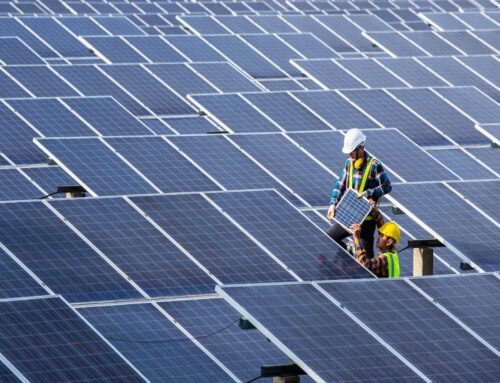
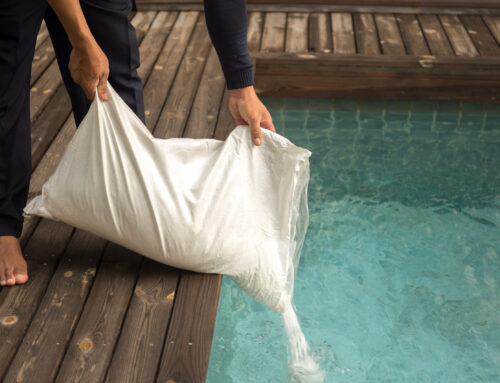
Leave A Comment
You must be logged in to post a comment.